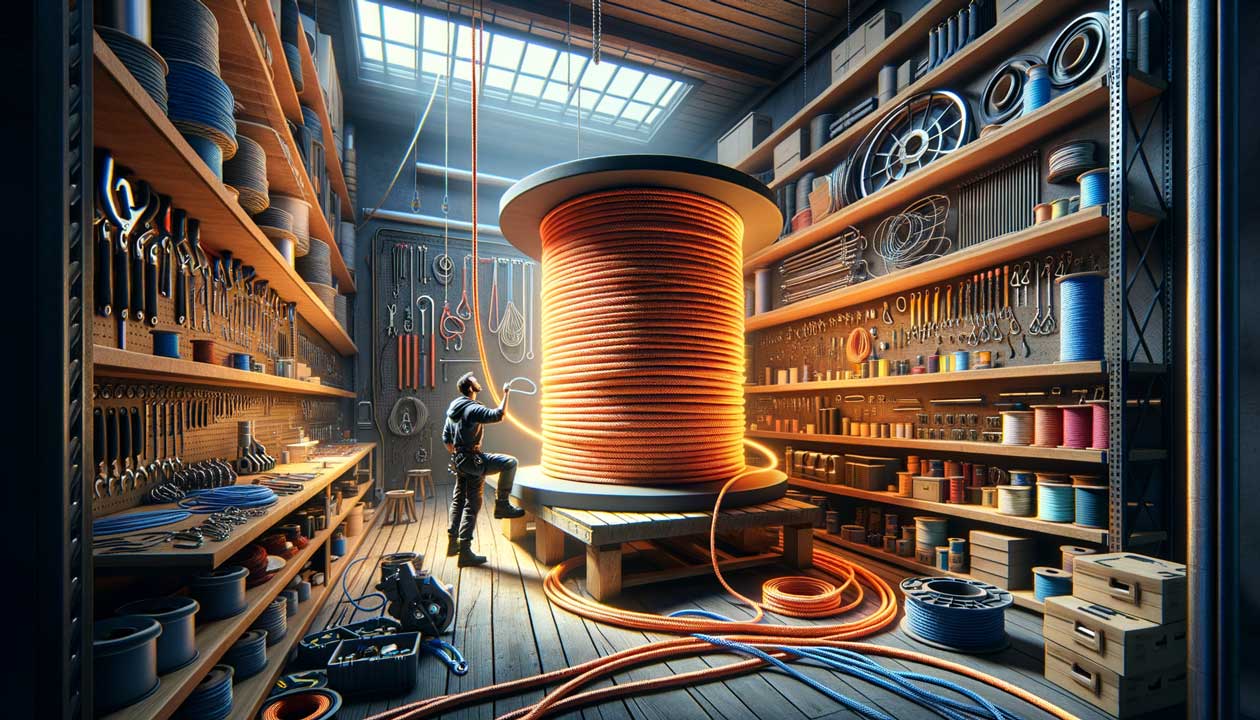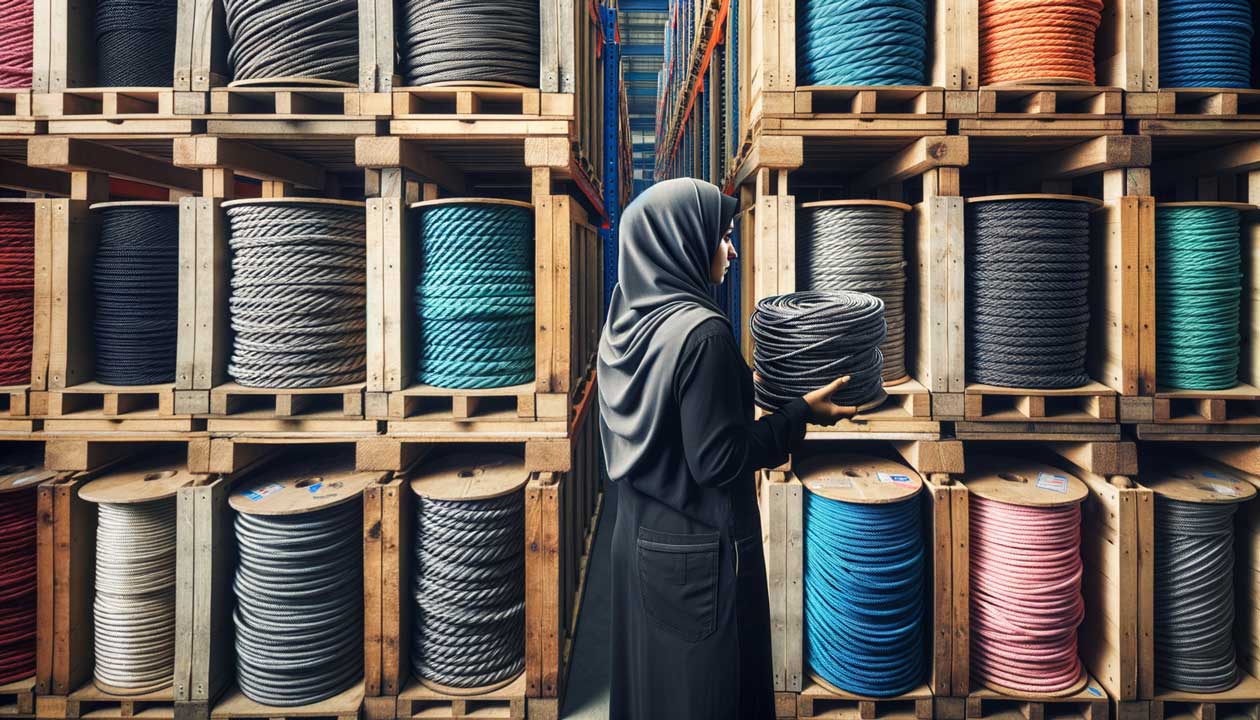In the ever-evolving world of ropes, the decision between synthetic and wire options isn't one to take lightly. As you embark on your next project, the choice becomes pivotal – a make-or-break moment that could define the success of your endeavour. So, join me on a journey as we unravel the secrets of this age-old dilemma: synthetic rope or wire rope clamp, which truly reigns supreme?
As an expert in the art of crafting captivating tales, I invite you to imagine a world where the lines between storytelling and reality blur. Picture this: you're perched atop a cliff, gazing out over the vast expanse of the ocean, the salty breeze caressing your face. In that heart-stopping moment, your choice of rope could mean the difference between an exhilarating adventure or a bone-chilling mishap.
But fear not, my friend, for in the pages that follow, we'll unravel the mysteries of these tightly wound fibers, uncovering the strengths and weaknesses that lie beneath their seemingly innocuous exteriors. Prepare to be enchanted as we delve into the world of synthetic ropes, unveiling their lightweight prowess and unparalleled durability in the face of the harshest elements.
Synthetic Rope vs. Wire Rope Clamps: Key Advantages
When it comes to choosing the right type of rope for your specific application, understanding the advantages of synthetic rope over traditional wire rope clamps can make all the difference. Synthetic ropes, made from materials like high-modulus polyethylene (HMPE) or polyester, offer a range of benefits that make them a superior choice in many situations.

Lightweight and Low Maintenance: Benefits of Synthetic Rope
- Lightweight design makes synthetic ropes easier to handle and transport compared to heavy wire rope clamps.
- No corrosion, kinking, or chemical absorption reduces maintenance requirements and extends the rope's service life.
- Improved abrasion resistance and UV protection enhance durability in harsh environments.
Increased Strength and Safety: Why Choose Synthetic Rope
Discover the superior strength-to-weight ratio and enhanced safety features of synthetic ropes.
Synthetic ropes boast a higher breaking strength-to-weight ratio compared to steel wire ropes, thanks to advancements in synthetic fiber technology. This means you can achieve the same or even better load-bearing capacity with a lighter, more manageable rope.
In addition, synthetic ropes offer better shock absorption and load dampening properties, which can greatly enhance safety in various applications. They are less prone to kinking, reducing the risk of injuries or accidents during use.

Imagine the possibilities when you switch to synthetic ropes – from marine and aviation applications to recreational use, the benefits are endless. Say goodbye to the limitations of wire rope clamps and hello to a new era of lightweight, strong, and versatile rope solutions.
Whether you're working in construction, mining, or industrial settings where wire rope clamps like the 1 rope clamp are commonly used, it's worth exploring the advantages that synthetic ropes can bring to your operations. With their increased strength, improved safety features, and low maintenance requirements, synthetic ropes are quickly becoming the preferred choice for a wide range of applications.
So, the next time you're considering a rope for your project, take a closer look at the benefits of synthetic ropes. You might be surprised at how they can revolutionize your work and take your operations to new heights.
Strength vs Durability Comparison
Unraveling the Interplay of Strength and Durability
Selecting the right rope is a balancing act between strength and durability. Let's explore how these crucial factors impact your choice.
When it comes to choosing between synthetic rope and wire rope clamps, understanding the concepts of strength and durability is essential. While both properties are important, they serve different purposes and can greatly influence the performance and longevity of your rope system.
Defining Strength and Durability
Strength refers to a rope's ability to withstand applied forces without breaking or deforming. It encompasses various measures such as tensile strength, which indicates the maximum load a rope can bear before breaking, and yield strength, which represents the point at which the rope begins to deform permanently.
On the other hand, durability is a measure of a rope's resistance to deterioration over time and under different environmental conditions. Factors like abrasion resistance, UV stability, and chemical resistance all contribute to a rope's overall durability.
Factors Affecting Strength and Durability
Several factors influence the strength and durability of ropes, whether synthetic or wire. The material composition plays a significant role, with synthetic fibers like high-modulus polyethylene (HMPE) and polyester offering exceptional strength-to-weight ratios compared to steel wire.
Manufacturing processes also impact strength and durability. Advances in synthetic fiber technology, such as improved fiber alignment and enhanced coatings, have led to the development of stronger and more durable synthetic ropes. Similarly, the construction and design of wire rope clamps, like the 1 rope clamp, affect their load-bearing capacity and resistance to wear and tear.
External factors, such as exposure to harsh environments, extreme temperatures, and corrosive substances, can also take a toll on a rope's strength and durability over time. Understanding these factors is crucial when selecting the appropriate rope for your specific application.
Importance of Strength and Durability Balance
Achieving the right balance between strength and durability is key to optimal rope performance. While synthetic ropes excel in terms of strength-to-weight ratio, they may not always match the durability of wire rope clamps in certain heavy-duty applications.
For example, in industries like construction and mining, where ropes are subjected to intense abrasion and frequent shock loads, the robustness of wire rope clamps like the 1 rope clamp may be preferable. However, in applications where weight savings and ease of handling are prioritized, such as in marine and recreational settings, the strength and flexibility of synthetic ropes shine.
Ultimately, finding the optimal balance between strength and durability depends on carefully evaluating your specific application requirements. Consider factors like the expected load capacity, environmental conditions, and potential hazards to make an informed decision that ensures reliable and long-lasting rope performance. For more insights, consider our "Why Synthetic Ropes Outperform Steel Lifting Cables" blog post.

By understanding the interplay between strength and durability, you can make a well-informed choice between synthetic rope and wire rope clamps. Whether you prioritize the lightweight and flexible nature of synthetic rope or the tried-and-true reliability of wire rope clamps like the 1 rope clamp, finding the right balance is essential for optimal performance and safety in your application. For more information, explore our premium quality rope solutions.
Applications and Markets: A Comprehensive Comparison
As we delve deeper into the world of ropes, it's crucial to understand how different applications and markets shape the demand for synthetic ropes and wire rope clamps. Let me share with you a fascinating comparison that will shed light on the evolving landscape of rope usage across various industries.
Did you know that the choice between synthetic rope and wire rope clamps can significantly impact the efficiency, safety, and cost-effectiveness of your operations? It's essential to align your rope selection with the specific requirements of your industry and application.
Synthetic Rope Gains Popularity in Various Industries
In recent years, synthetic ropes have experienced a surge in popularity across a wide range of industries. Their lightweight nature, superior strength-to-weight ratio, and enhanced flexibility have made them a go-to choice for many applications.
- Marine and aviation sectors have embraced synthetic ropes for their corrosion resistance, ease of handling, and reduced weight, which translates to improved fuel efficiency and enhanced safety.
- Recreational activities such as camping, hiking, and water sports have also witnessed a growing demand for synthetic ropes due to their durability, low maintenance requirements, and versatility.
The rising popularity of synthetic ropes can be attributed to the growing demand for lightweight and high-performance solutions. Industries are constantly seeking ways to optimize their operations, reduce costs, and improve safety standards. Synthetic ropes, with their advanced properties and customization options, have emerged as a compelling alternative to traditional wire rope clamps in many scenarios.
Wire Rope Clamp Remains Essential in Specific Markets
While synthetic ropes are making significant strides, it's important to recognize that wire rope clamps, like the 1 rope clamp, still hold a crucial place in specific markets and applications.
- Construction, mining, and industrial sectors often rely on wire rope clamps for their unparalleled strength, durability, and resistance to extreme loads and harsh environments.
- Heavy-duty applications that involve frequent shock loads, intense abrasion, or exposure to high temperatures may require the robustness and reliability of wire rope clamps.
In these demanding settings, the 1 rope clamp remains a commonly used accessory for securing wire ropes. Its design ensures a firm grip and reliable connection, making it an indispensable component in many industrial and construction projects.
It's worth noting that the choice between synthetic ropes and wire rope clamps is not always a binary one. In some cases, a combination of both types of ropes may be employed to achieve the desired performance and safety standards. The key is to carefully assess the specific requirements of your application and consult with rope experts to determine the optimal solution.
Expert Tip
When selecting between synthetic ropes and wire rope clamps, consider factors such as load capacity, environmental conditions, ease of handling, and maintenance requirements. Don't hesitate to seek guidance from experienced professionals to ensure you make an informed decision that optimizes your operations and ensures the safety of your team.
As industries continue to evolve and new challenges arise, the application and market comparison between synthetic ropes and wire rope clamps will remain a dynamic and ever-changing landscape. By staying informed about the latest advancements in rope technology and understanding the unique requirements of your industry, you can make well-informed decisions that optimize your operations and ensure the success of your projects. For information on tailored options, check our page on customizing ropes to meet your needs.
Cost and Maintenance Considerations
As a savvy business owner or operator, one of the most critical factors to consider when choosing between synthetic ropes and wire rope clamps is the overall cost and maintenance requirements. Let's take a closer look at how these two options stack up against each other in terms of initial investment, long-term cost-effectiveness, and upkeep.
Factors Influencing Maintenance Costs
Several key factors can significantly impact the maintenance costs associated with your rope system, whether you opt for synthetic ropes or wire rope clamps like the 1 rope clamp. These include:
- Frequency of use and load capacity - Ropes and clamps subjected to frequent, heavy loads may require more frequent inspections and replacements.
- Environmental conditions - Exposure to harsh weather, UV radiation, chemicals, or extreme temperatures can accelerate wear and tear.
- Proper installation and handling - Improper installation or mishandling of ropes and clamps can lead to premature damage and increased maintenance needs.
By understanding these factors and how they apply to your specific application, you can make a more informed decision when selecting between synthetic ropes and wire rope clamps.
In my experience, investing in high-quality synthetic ropes has proven to be a game-changer for our marine operations. Not only have we seen reduced maintenance costs, but the improved safety and efficiency have been invaluable.
Types of Maintenance Expenses
When budgeting for maintenance costs, it's essential to consider both direct and indirect expenses. Direct costs include:
- Routine inspections and testing to ensure the integrity and performance of your ropes and clamps.
- Repairs and replacements of damaged or worn-out components.
- Cleaning and lubrication to extend the life of your equipment.
Indirect costs, while less tangible, can also add up over time. These may include:
- Lost productivity due to equipment downtime for maintenance.
- Potential safety incidents resulting from poorly maintained ropes or clamps.
- Increased energy consumption from inefficient or damaged equipment.
By carefully considering both direct and indirect maintenance expenses, you can develop a more accurate cost comparison between synthetic ropes and wire rope clamps for your application.
The Bottom Line on Cost and Maintenance
While the initial cost of synthetic ropes may be higher than wire rope clamps, their long-term cost-effectiveness, reduced maintenance requirements, and extended service life often make them the smarter choice in the long run.
Ultimately, the decision between synthetic ropes and wire rope clamps will depend on your unique application, budget, and maintenance capabilities. By carefully weighing the initial costs, long-term maintenance requirements, and potential indirect expenses, you can make an informed choice that maximises the efficiency, safety, and profitability of your operations.
Comparing synthetic rope and wire rope clamp reveals numerous advantages of synthetic variants, from being lightweight, flexible, and non-corrosive to providing superior strength-to-weight ratios. While wire rope clamps like the 1 rope clamp excel in heavy-duty applications and offer excellent tensile strength, synthetic ropes are gaining traction in marine, aviation, and recreational sectors due to their low maintenance and high performance. Choosing between these options hinges on specific application needs, market trends, and cost considerations.
Empower Your Choice: Get Expert Advice Now!
Fill in the inquiry form above to learn more about how the advantages of synthetic rope could revolutionise your operations and to receive custom rope solutions tailored to your needs.